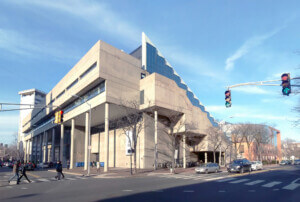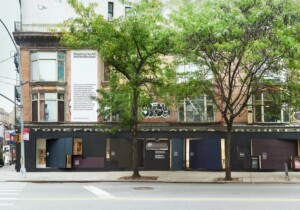Kevin Greenberg sends us another insightful dispatch from Kenmare Street:
Last Tuesday, the Storefront for Art and Architecture felt like a satellite campus of the GSD as Harvard students and other Cambridgians joined locals at the Storefront for a release party for the second issue of New Geographies, a doctoral student-edited periodical recently launched by the GSD’s Aga Khan Program. The editors of New Geographies, Neyran Turan and Stephan Ramos, told us that they had several meanings in mind when they chose the theme for the second issue. Titled “After Zero,” the issue centers on the slippery idea of a “zero point.” The editors cite zero carbon and “zero context” urban developments (or “cities from scratch”) as contemporary examples that force designers to question design methodologies and justifications.
Nothing makes for compelling architectural discourse like a nice, open-ended theme. The zero in question might be seen as a tabula rasa from which to proceed, but it’s also a means of marking a significant event. In the context of the current climate, zero is also a code word for crisis. How should architects and designers re-frame interventions after the global economic downturn, in an age when the glitzy mega-developments that grew like crystals in the Persian Gulf suddenly seem like relics of a recently bygone age? What kind of models for future urbanism can we realistically project? These are among the questions that interest the journal’s editors and contributors.
You have to hand it to them, too: “After Zero” is a handsome, considered object. Design duties were handled by NYC-based Thumb, who also manage graphic design for Princeton Architectural Press’s 306090, and they do a great job presenting articles from a host of notables, including Keller Easterling, Joseph Grima and Peter Hall. While a few contributors chose to focus on the bizarre urbanism of the Persian Gulf, the “geographies” analyzed really range in their scope and locale from the arctic to Africa, from China to goode olde Europe. Matthew Gandy’s article on French landscape architect Gilles Clement’s “paradise of weeds,” for example, is an interesting interpretation of the issue’s theme and will seem timely to anyone who’s recently visited the High Line.
Turan and Ramos were on hand Tuesday to briefly present the new volume, and Harvard professor Hashim Sarkis offered a few words both on the significance of some of the nascent issues that are the theme of “After Zero” and of New Geographies itself. Sarkis gave a little insight into yet another shade of meaning of the “zero” in the volume’s title: It’s a nod to the survival of the journal itself. The inaugural issue of New Geographies, released last year, was numbered zero. Since, as Sarkis noted, many student-run publications start with the first issue and end with the first issue, the release of “After Zero” is cause for celebration indeed.
Afterwards the audience sipped prosecco and queued up to purchase copies of the journal, which quickly sold out.










